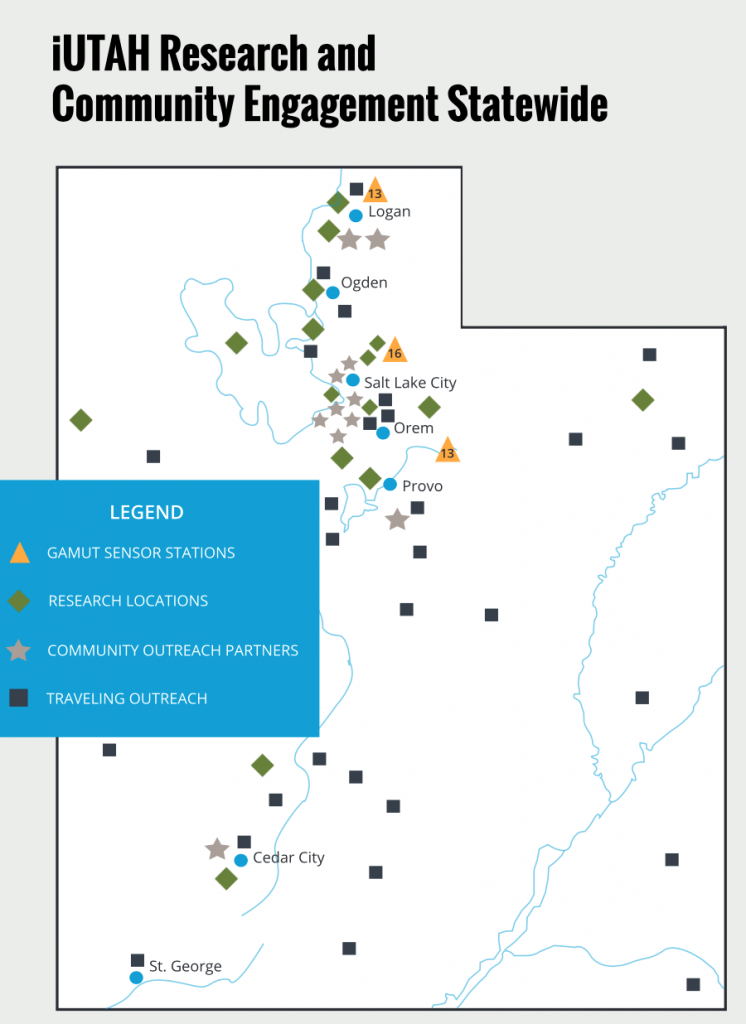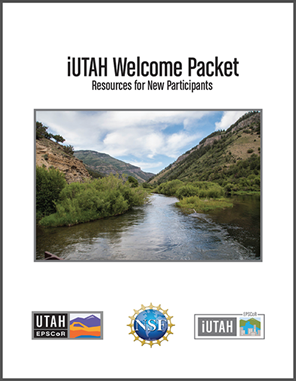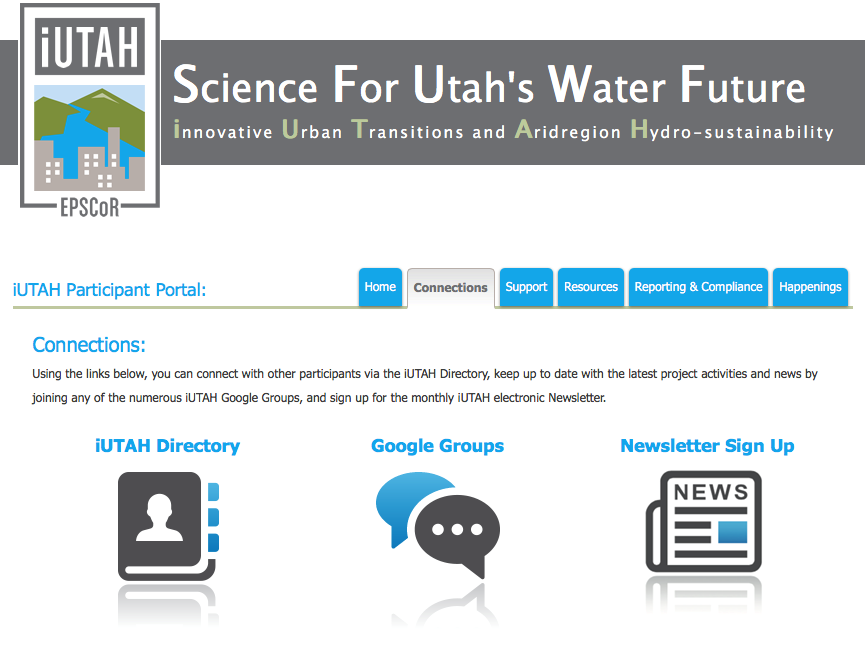We’re continuing to share reflections from the 2017 Community Engagement Fellows on the blog. In today’s post, Andy Leidolf introduces his four part series, “The Community Manager’s Survival Guide: Building Social Capital in Large, Heterogeneous, Geographically Dispersed Research Networks.” You can catch up on all posts by the Fellows here.
Posted by Andy Leidolf, Coordinator, Honors Program, Utah State University, and Executive Director, Society for Freshwater Science. Leidolf served as iUTAH Assistant Director and Project Administrator from 2014-2018.
The Challenge
When I began my tenure as Assistant Director of the iUTAH EPSCoR project in October 2014, the fact that the members of my research collaboration were not co-located, but dispersed among eleven institutions of higher learning spread all over the state of Utah, as well as 100 state, national, and—in some cases—international partner organizations, made settling into my position, frankly, a scary prospect. We were funded by a five year, $20M grant from the National Science Foundation to enhance Utah’s water resources through research, training, and education. This included studying the state’s water system, as well as working to understand how factors like population growth, climate variability, changes in land use, and human behavior impacted the sustainability of our state’s water resources. No small feat. How was I ever going to learn who all these people were, what role they played in and for our community, and—most importantly—how to communicate and engage with them?

At the time, we were not even at the mid-point of our five-year project, which is to say we were still growing and actively recruiting new participants and partners. So, in addition to a logistically daunting status quo, I was also chasing a moving target with its own challenges. How do I welcome and onboard new members of my community in a manner that sets them and us up for success? How do I secure meaningful, productive, and sustained engagement?
Wait—There’s a Theory for That?
As it turns out, none of these challenges are new, and they’re not exactly surprising or unheard of. We know from the Science of Team Science, specifically work conducted by Nancy J. Cooke of Arizona State University, that teams such as iUTAH—large, diverse, multi-institutional, and spatially dispersed—suffer from a multitude of challenges: permeable boundaries and dynamic membership, misalignment of goals, conflicts created by differences in institutional culture and work style, and magnified communication and coordination burdens.
My initial survey of “iUTAH-land,” conducted over the first month through a series of conversations, discussions, and informal Q&A’s with a diverse range of project participants from across the state, bore much of this out. New participants would “join” the project through one of its many programs, only to quickly fall off the radar, never to be heard from again.
New and old hands alike experienced difficulties in navigating the project infrastructure and were unsure about where to go for information, documentation, or support. We had a website, chock-full of “stuff,” but it was not clear who the intended audience was: our participants, their stakeholders, the general public? No one knew, and as a result, the site failed to provide meaningful engagement with any one of these important constituencies.
Onboarding New Participants – The iUTAH Welcome Packet
Equipped with some theory and an initial diagnosis, I first set about to tackle our challenges in onboarding new participants by putting myself in their shoes. It occurred to me that:
1) If I were new to a large, complex project such as iUTAH, what I’d really want was for someone to hand me a manual—something to get me up to speed; learn the language, culture, and norms; maybe get some phone numbers and a cheat sheet of who to contact about, well, everything!
2) I was new to a large, complex project and someone did in fact hand me a manual my first day on the job. Imaginatively called the “iUTAH Assistant Director/Project Administrator Job Manual,” it sat on my desk right next to my computer display in all its comforting grey, three-ring binder glory. I had read it cover-to-cover on my first day in the office, many more times since then, and still referred to it daily, sometimes hourly.
Manuals, or playbooks, are nothing new in community management. But they are frequently internal documents for community management/engagement professionals to document, among others, the vision, mission, objectives, workflows, processes, and resources of their community. I think what we sometimes forget is that our new community members, particularly where large, complex communities are concerned, need a playbook, too!
So, with the help of the iUTAH Project Office Staff, I set about creating the “iUTAH Welcome Packet—Resources for New Participants.” This 17-page booklet, which underwent numerous updates and revisions over the years, continued to serve as our primary tool for welcoming new participants for the duration of the project, orienting them to the project, and setting them up for a successful integration into iUTAH and sustained engagement with its staff, participants, and central research, training, education, and outreach themes.

The booklet
- includes messages from project leadership welcoming new participants into the iUTAH family;
- summarizes the project’s vision, mission, objectives, and underlying philosophy;
- details project values, norms, and policies and articulates expectations and participant responsibilities;
- provides an overview of the iUTAH organization and infrastructure, including communication channels, collaboration tools, and reporting interfaces;
- introduces Project Office staff, their areas of responsibility, and contact information;
- lists resources and available participant support;
- provides action items, to-dos, check lists and quick-reference guides to facilitate rapid and smooth integration.
While the Welcome Packet has been well-received by new participants, it is notable that it is most frequently requested by people who have already been involved with the iUTAH project, in some instances since inception. I guess when it comes to large, geographically dispersed research networks, we all need a manual from time to time.
Adding Value to Participant Engagement – The iUTAH Participant Portal
The second major task I took on after having joined iUTAH was to overcome the communication and coordination challenges posed by the statewide nature of our project and the associated geographic dispersion of its participants. This entailed recognizing that outreach, i.e., connecting with people outside of our community, and “inreach,” engaging our participants, were fundamentally two very different activities requiring separate, customized approaches. It also meant disentangling outreach and inreach functions across our project’s infrastructure, but most importantly on our website. With the help of the iUTAH Communications Team and our web designer and web programmer from the Utah Education Network, we began a long and arduous process of building, in essence, two separate web sites: one externally-faced, and an inward-facing “members only” portal for our participants.

To add value and promote engagement with this new tool, we built in many of the functions that our participants most frequently encountered problems with:
- Facilitating “Connections”
- Directory of project participants, complete with individual profiles made up of head shots, bios, description of project role(s), areas of expertise, professional interests, and contact information
- Automated functions allowing users to sign on to Google groups and e-newsletter distribution lists, or request video conferencing support
- Providing “Support”
- Automated workflows for requesting travel support or making topical or general inquiries
- Sharing “Resources”
- Welcome Packet
- Monthly e-newsletter archive
- Annual Newsletter archive
- Project brochures and flyers
- Videos and webinars
- User guides and tutorials
- Logos and templates
- Documents and presentations
- Team meeting minutes
- Motivating “Reporting & Compliance”
- Automated workflows for submission of Scopes of Work and Data Collection Plans
- Links to external Drupal interface for reporting of outputs and outcomes
“Inreach” as a Way to Build Social Capital?
I believe that channeling much of my time and energy early on into connecting with our participants and—more importantly—connecting them with one another, went a long way towards building the social capital that allowed me to tackle even bigger challenges over time. Next time, I’ll recount some important lessons I learned on a road trip across our state about dealing with institutional diversity and (real or perceived) power imbalances among members of my community. See you then!
Next in the series: Addressing Institutional Diversity and Power Imbalance by Promoting Community Equity, Tolerance, and Fairness